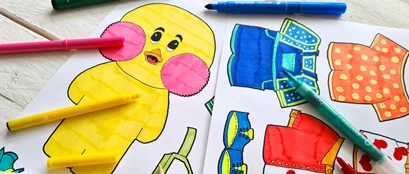
Japanese tea room
A tea room or chashitsu (茶室) is a traditional Japanese space designed to be used for tea ceremonies. The term can be used for free-standing tea houses, but also for individual rooms intended for tea ceremonies. Since they are significant elements of Japanese culture and have been for ages, tea rooms are a popular subject for traditional drawings and prints.
In this step-by-step plan we will show you how to recreate your own Japanese-inspired tea room! Since the drawings from the Japanese antiquity are often perfectly straight, we decided to imitate these straight lines by cutting them. Let's begin!
What you need
- Sakura Koi Coloring Brush Pen set of 24
- Sakura XS mechanical pencil in 0.7 mm
- Van Gogh water colour paper of 300 g/m² in 24 x 30 cm
- Water colour brush
- Ruler
- Scissors
- Glue
- Water
Step 1
Sketch the contours for the walls and floor of the room using your ruler and the mechanical pencil on a sheet of water colour paper.

Step 2
Use the Koi Coloring Brush Pens in different colours to create large colour samples on separate sheets of the water colour paper. The set of 24 brush pens contains several shades of the same colour to create some beautiful colour gradients! You can choose any colour scheme you like. We decided to go for softer colours to recreate the calm vibes of an actual tea room.
Set the samples aside for now, they will be used later to create the different elements of the tea room.

Step 3
Cut out four strips of one of the colour samples to create the frame of the sliding doors. Since traditional tea rooms are made out of wood, we used the yellow ochre colour sample. You can still see the drawing pattern in the colour, which makes the frame look more like wood! Once you are happy with the size of the strips and their placement, glue them down onto your drawing.

Step 4
Now cut out a sample to make the floor. We went for a soft, mint colour to symbolize the traditional tatami mats of a traditional tea room. You don’t have to worry about the direction of the lines in your colour blocks, different directions in a drawing add a dynamic, playful effect.

Step 5
To provide some contrast to the soft colours of the room, we decided to add a little black. Use the black brush pen on the first part of a separate piece of paper. Now add some water with your brush to dilute it and create a water colour effect! Wait for the sample to dry completely before cutting it and using it for the screens.

Step 6
Use more of this diluted black to create a stone notch in the floor for the teapot to stand on.

Step 7
A tea ceremony also includes a beautiful low wooden table on which the cups and other tea ceremony related items are placed on. For this table we used some darker brown shades. The drawing pattern on this piece resembles a wood grain because of the different shades. Experiment with light and dark shades to avoid flattening your drawing.

Step 8
Create the teacups. We used a soft blue shade to resemble stone, but you can of course use any colour you like. Then cut out your teapot and other items you want to include on the table. We added some traditional sweets (wagashi) in pink.
This completes your very own little tea room. We hope you liked this step-by-step plan!

Other step-by-step ideas

Drawing a turtle with Ecoline Duotip
Step-by-step plan
Drawing a Japanese beetle
Step-by-step plan


